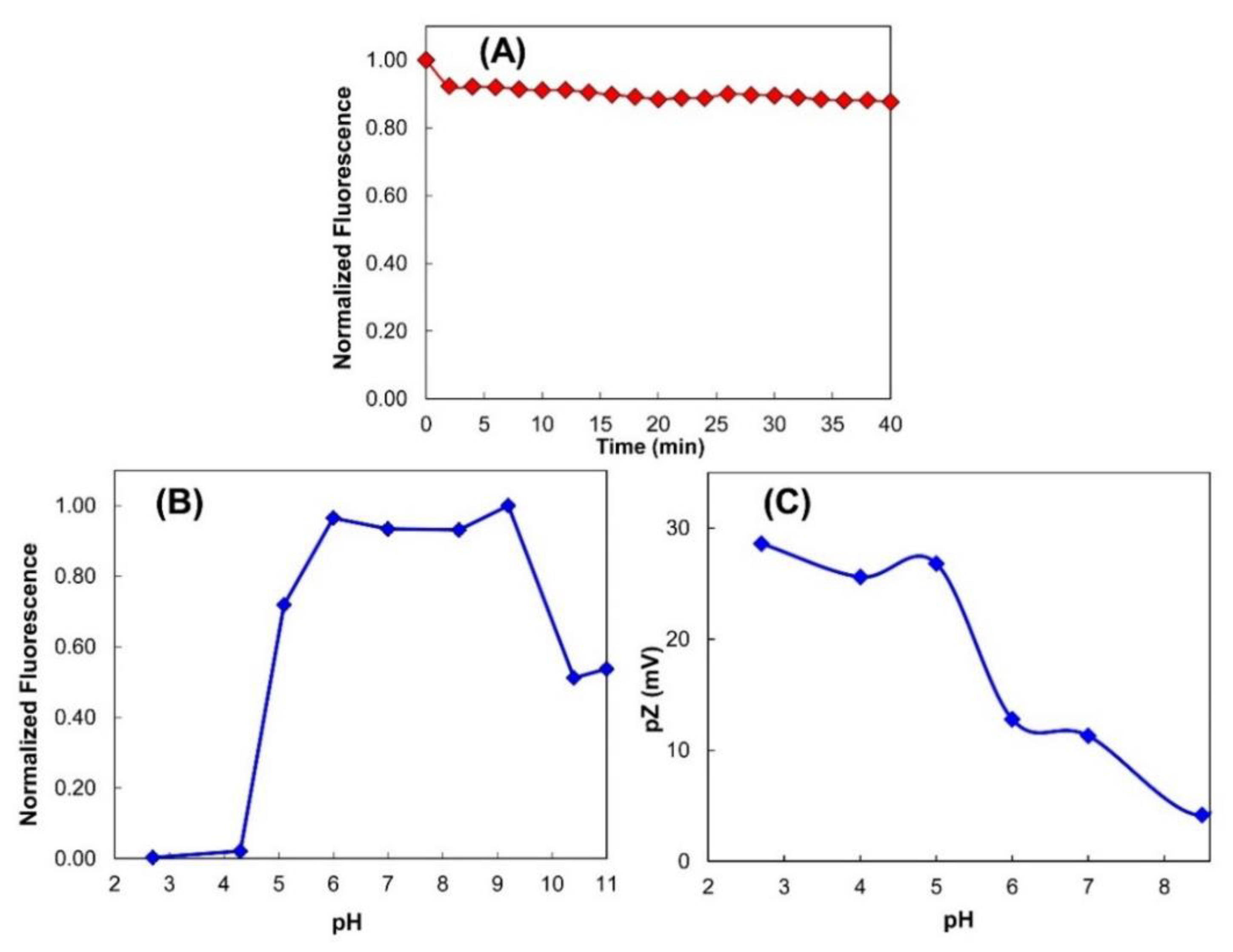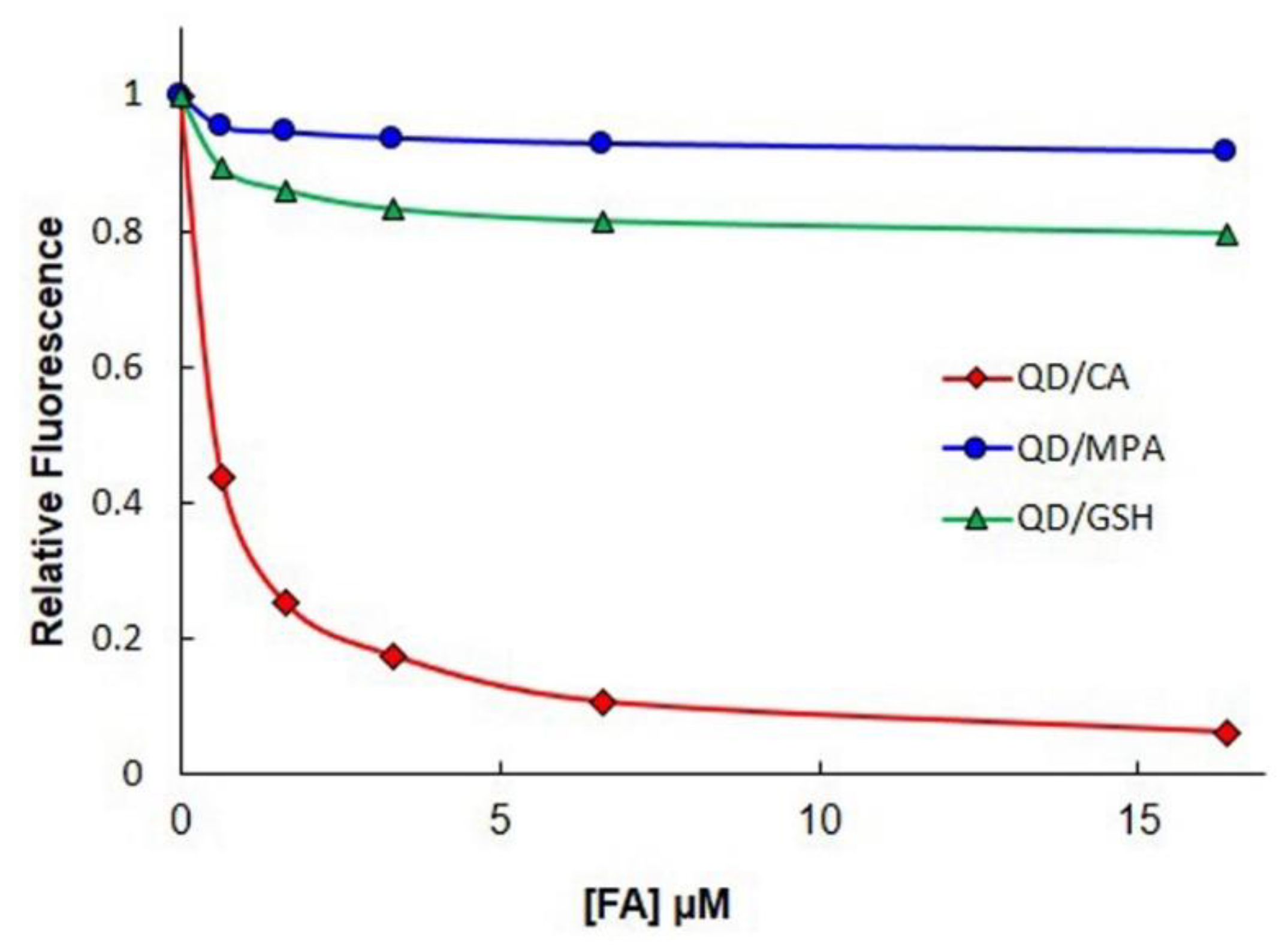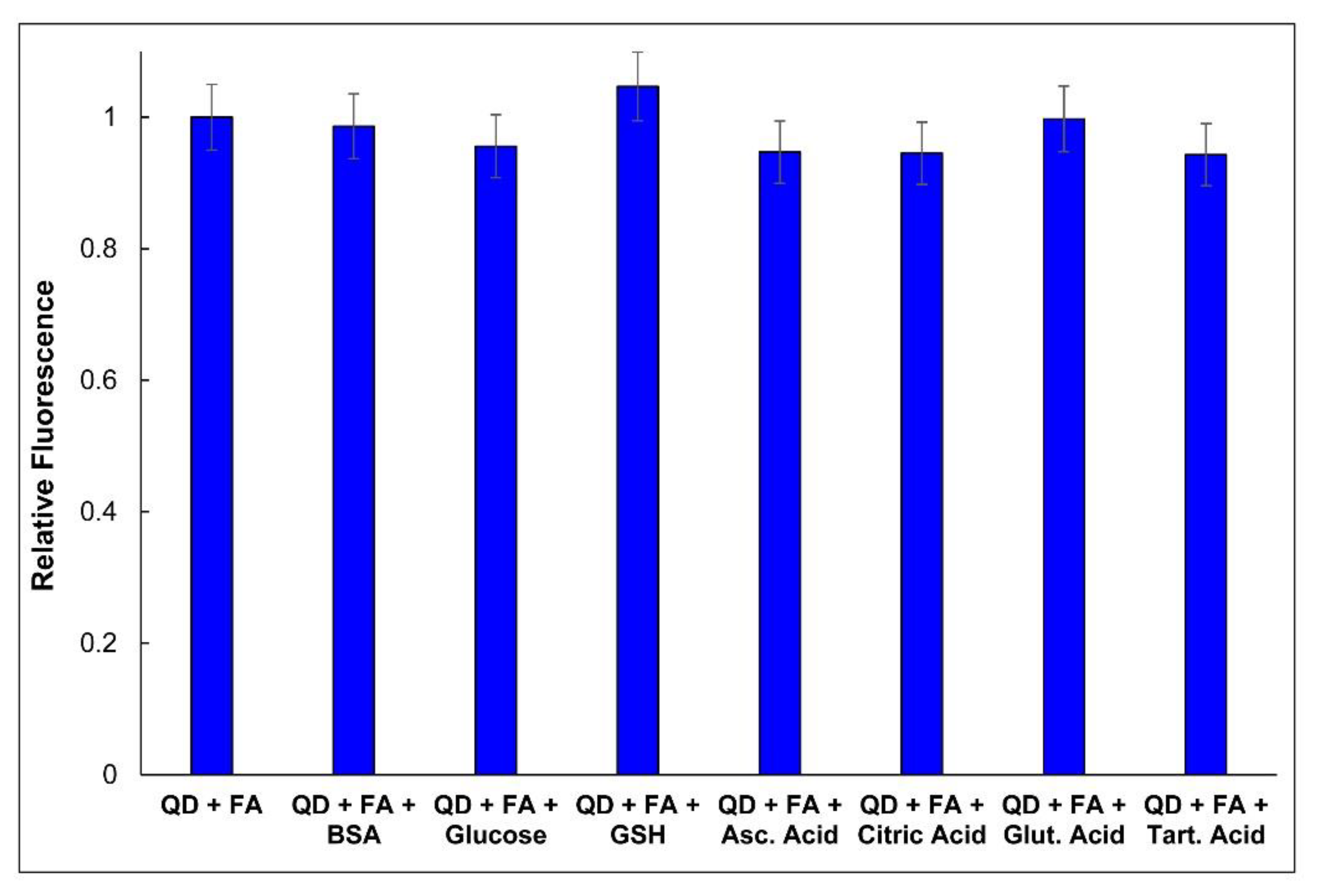CdTe Quantum Dots Modified with Cysteamine: A New Efficient Nanosensor for the Determination of Folic Acid
Abstract
1. Introduction
2. Materials and Methods
2.1. Reagents
2.2. Characterization of Thiol-Capped Nanoparticles
2.3. Preparation of GSH, MPA, and CA-Capped CdTe QDs
2.4. Stability Study
2.5. Fluorescence Study
2.6. Interference Study
2.7. Sensitivity Detection
2.8. Detection of FA in Real Samples
3. Results and Discussion
3.1. Spectral Characteristics of CdTe QDs
3.2. Photostability of CdTe/CA QDs
3.3. Effect of pH
3.4. Fluorescence Quenching of Thiol-Capped CdTe QDs by FA
3.5. Mechanism of Quenching
Calculation of Free Energy (ΔGet) for the Electron Transfer Process
3.6. Selectivity of CA-Capped QD Sensor for FA Detection
3.7. Analysis of Real Samples with the Proposed Nanosensor
4. Conclusions
Supplementary Materials
Author Contributions
Funding
Acknowledgments
Conflicts of Interest
References
- Liang, L.; Subirade, M. β-lactoglobulin/folic acid complexes: Formation, characterization, and biological implication. J. Phys. Chem. B 2010, 114, 6707–6712. [Google Scholar] [CrossRef] [PubMed]
- Wang, X.; Qin, X.; Demirtas, H.; Li, J.; Mao, G.; Huo, Y.; Sun, N.; Liu, L.; Xu, X. Efficacy of folic acid supplementation in stroke prevention: A meta-analysis. Lancet 2007, 369, 1876–1882. [Google Scholar] [CrossRef]
- Lucock, M. Folic Acid: Nutritional biochemistry, molecular biology, and role in disease processes. Mol. Genet. Metab. 2000, 71, 121–138. [Google Scholar] [CrossRef] [PubMed]
- Hoegger, D.; Morier, P.; Vollet, C.; Heini, D.; Reymond, F.; Rossier, J.S. Disposable microfluidic ELISA for the rapid determination of folic acid content in food products. Anal. Bioanal. Chem. 2007, 387, 267–275. [Google Scholar] [CrossRef] [PubMed]
- Morrow, J.D.; Kelsey, K. Folic acid for prevention of neural tube defects: Pediatric anticipatory guidance. J. Pediatr. Health Care 1998, 12, 55–59. [Google Scholar] [CrossRef]
- Weitman, S.D.; Lark, R.H.; Coney, L.R.; Fort, D.W.; Frasca, V.; Zurawski, V.R.; Kamen, B.A. Distribution of the folate receptor GP38 in normal and malignant-cell lines and tissues. Cancer Res. 1992, 52, 3396–3401. [Google Scholar] [PubMed]
- Ross, J.F.; Chaudhuri, P.K.; Ratnam, M. Differential regulation of folate receptor isoforms in normal and m- tissues in-vivo and in established cell-lines: Physiological and clinical implications. Cancer 1994, 73, 2432–2443. [Google Scholar] [CrossRef]
- Liu, P.; Liu, D.; Liu, Y.; Li, L. ANTS-anchored Zn-Al-CO3-LDH particles as fluorescent probe for sensing of folic acid. J. Solid State Chem. 2016, 241, 164–172. [Google Scholar] [CrossRef]
- Nagaraja, P.; Vasantha, R.A.; Yathirajan, H.S. Spectrophotometric determination of folic acid in pharmaceutical preparations by coupling reactions with iminodibenzyl or 3-aminophenol or sodium molybdate-pyrocatechol. Anal. Biochem. 2002, 307, 316–321. [Google Scholar] [CrossRef]
- Buhl, F.; Hachula, U. Spectrophotometric determination of folic acid and other reductants using couplet redox-complexation reaction with Ce(IV) and arsenazo III. Chem. Anal. (Wars.) 1991, 36, 27–34. [Google Scholar]
- Le Gall, A.-C.; van den Berg, C.M.G. Determination of folic acid in sea water using adsorptive cathodic stripping voltammetry. Anal. Chim. Acta 1993, 282, 459–470. [Google Scholar] [CrossRef]
- Szczepaniak, W.; Ren, M. Adsorptive stripping voltammetric determination of folic acid in pharmaceutical preparations. Electroanalysis 1994, 6, 505–507. [Google Scholar] [CrossRef]
- Akhtar, M.J.; Khan, M.A.; Ahmad, I. High performance liquid chromatographic determination of folic acid and its photodegradation products in the presence of riboflavin. J. Pharm. Biomed. Anal. 1997, 16, 95–99. [Google Scholar] [CrossRef]
- Patring, J.D.M.; Jastrebova, J.A. Application of liquid chromatography-electrospray ionization mass spectrometry for determination of dietary folates: Effects of buffer nature and mobile phase composition on sensitivity and selectivity. J. Chromatogr. A 2007, 1143, 72–82. [Google Scholar] [CrossRef] [PubMed]
- Breithaupt, D.E. Determination of folic acid by ion-pair RP-HPLC in vitamin-fortified fruit juices after solid-phase extraction. Food Chem. 2001, 74, 521–525. [Google Scholar] [CrossRef]
- Wang, F.; Cao, M.; Wang, N.; Muhammada, N.; Wuc, S.; Zhu, Y. Simple coupled ultrahigh performance liquid chromatography and ion chromatography technique for simultaneous determination of folic acid and inorganic anions in folic acid tablets. Food Chem. 2018, 239, 62–67. [Google Scholar] [CrossRef]
- Jou, A.F.; Lu, C.-H.; Ou, Y.-C.; Wang, S.-S.; Hsu, S.-L.; Willner, I.; Ho, J.A. Diagnosing the miR-141 prostate cancer biomarker using nucleic acid-functionalized CdSe/ZnS QDs and telomerase. Chem. Sci. 2015, 6, 659–665. [Google Scholar] [CrossRef]
- Jokerst, J.V.; Raamanathan, A.; Christodoulides, N.; Floriano, P.N.; Pollard, A.A.; Simmons, G.W.; Wong, J.; Gage, C.; Furmaga, W.B.; Redding, S.W.; et al. Nano-bio-chips for high performance multiplexed protein detection: Determinations of cancer biomarkers in serum and saliva using quantum dot bioconjugate labels. Biosens. Bioelectron. 2009, 24, 3622–3629. [Google Scholar] [CrossRef]
- Chang, N.; Lu, Y.; Mao, J.; Yang, J.; Li, M.; Zhang, S.; Liu, Y. Ratiometric fluorescent sensor array based on quantum dots for detection of proteins. Analyst 2016, 141, 2046–2052. [Google Scholar] [CrossRef]
- Probst, C.E.; Zrazhevskiy, P.; Bagalkot, V.; Gao, X. Quantum dots as a platform for nanoparticle drug delivery vehicle design. Adv. Drug Deliv. Rev. 2013, 65, 703–718. [Google Scholar] [CrossRef]
- Du, J.; Du, Z.; Hu, J.-S.; Pan, Z.; Shen, Q.; Sun, J.; Long, D.; Dong, H.; Sun, L.; Zhong, X.; et al. Zn−Cu−In−Se quantum dot solar cells with a certified power conversion efficiency of 11.6%. J. Am. Chem. Soc. 2016, 138, 4201–4209. [Google Scholar] [CrossRef] [PubMed]
- Ren, W.; Fang, Y.; Wang, E. A binary functional substrate for enrichment and ultrasensitive SERS spectroscopic detection of folic acid using graphene oxide/Ag nanoparticle hybrids. ACS Nano 2011, 5, 6425–6433. [Google Scholar] [CrossRef] [PubMed]
- Hemmateenejad, B.; Shakerizadeh-shirazi, F.; Samari, F. BSA-modified gold nanoclusters for sensing of folic acid. Sens. Actuators B Chem. 2014, 199, 42–46. [Google Scholar] [CrossRef]
- Mazloum-Ardakania, M.; Beitollahi, H.; Amini, M.K.; Mirkhalaf, F.; Abdollahi-Alibeik, M. New strategy for simultaneous and selective voltammetric determination of norepinephrine, acetaminophen and folic acid using ZrO2 nanoparticles-modified carbon paste electrode. Sens. Actuators B Chem. 2010, 151, 243–249. [Google Scholar] [CrossRef]
- Wang, Y.; Zheng, J.; Zhang, Z.; Yuan, C.; Fu, D. CdTe nanocrystals as luminescent probes for detecting ATP, folic acid and l-cysteine in aqueous solution. Colloids Surf. A 2009, 342, 102–106. [Google Scholar] [CrossRef]
- Geszke-Moritz, M.; Clavier, G.; Lulek, J.; Schneider, R. Copper- or manganese-doped ZnS quantum dots as fluorescent probes for detecting folic acid in aqueous media. J. Lumin. 2012, 132, 987–991. [Google Scholar] [CrossRef]
- Kuang, R.; Kuang, X.; Pan, S.; Zheng, X.; Duan, J.; Duan, Y. Synthesis of cysteamine-coated CdTe quantum dots for the detection of bisphenol A. Microchim. Acta 2010, 169, 109–115. [Google Scholar] [CrossRef]
- Zhang, T.; Sun, X.; Li, B. Synthesis of positively charged CdTe quantum dots and detection for uric acid. Spectrochim. Acta A 2011, 79, 1566–1572. [Google Scholar] [CrossRef]
- Callan, J.F.; Mulrooney, R.C.; Kamila, S. Luminescent detection of ATP in aqueous solution using positively charged CdSe–ZnS quantum dots. J. Fluoresc. 2008, 18, 1157–1161. [Google Scholar] [CrossRef]
- Lee, J.; Choi, Y.; Kim, J.; Park, E.; Song, R. Positively charged compact quantum dot–DNA complexes for detection of nucleic acids. ChemPhysChem 2009, 10, 806–811. [Google Scholar] [CrossRef]
- Ramírez-Herrera, D.E.; Tirado-Guízar, A.; Paraguay-Delgado, F.; Pina-Luis, G. Ratiometric arginine assay based on FRET between CdTe quantum dots and Cresyl violet. Microchim. Acta 2017, 184, 1997–2005. [Google Scholar] [CrossRef]
- Tirado-Guizar, A.; Pina-Luis, G.; Paraguay-Delgado, F. Fluorescence enhancement study of shell-less CdTe quantum dots. Mat. Express 2015, 5, 33–40. [Google Scholar] [CrossRef]
- Yu, W.W.; Qu, L.H.; Guo, W.Z.; Peng, X.G. Experimental determination of the extinction coefficient of CdTe, CdSe and CdS nanocrystals. Chem. Mater. 2003, 15, 2854–2860. [Google Scholar] [CrossRef]
- Aldana, J.; Lavelle, N.; Wang, Y.; Peng, X. Size-dependent dissociation pH of thiolate ligands from cadmium chalcogenide nanocrystals. J. Am. Chem. Soc. 2005, 127, 2496–2504. [Google Scholar] [CrossRef]
- Zhang, Y.; Mi, L.; Wang, P.; Mab, J.; Chen, J. pH-dependent aggregation and photoluminescence behavior of thiol-capped CdTe quantum dots in aqueous solutions. J. Lumin. 2008, 128, 1948–1951. [Google Scholar] [CrossRef]
- Hall, H.K. Correlation of the Base Strengths of Amines. J. Am. Chem. Soc. 1957, 79, 5441–5444. [Google Scholar] [CrossRef]
- Kavarnos, G.J. Fundamental Concepts of Photoinduced Electron Transfer. In Photoinduced Electron Transfer I, Topics in Current Chemistry; Springer: Berlin/Heidelberg, Germany, 1990; Volume 156. [Google Scholar]
- Zhang, X.; Ju, H.; Wang, J. (Eds.) Electrochemical Sensors, Biosensors and Their Biomedical Applications; Academic Press: San Diego, CA, USA, 2008; p. 158. [Google Scholar]
- Dawson, R.M.C.; Elliott, D.C.; Elliott, W.H.; Jones, K.M. Data for Biochemical Research, 3rd ed.; Clarendon Press: Oxford, UK, 1986. [Google Scholar]
- Serjeant, E.P.; Dempsey, B. Ionisation Constants of Organic Acids in Aqueous Solution; IUPAC Chemical Data Series No. 23; International Union of Pure and Applied Chemistry (IUPAC): Research Triangle Park, NC, USA; New York, NY, USA; Pergamon Press, Inc.: Oxford, UK, 1979; p. 36. [Google Scholar]
- Boaz, H.; Rollefson, G.K. The quenching of fluorescence. Deviations from the Stern-Volmer law. J. Am. Chem. Soc. 1950, 72, 3435–3443. [Google Scholar] [CrossRef]
- Zhao, D.; Chan, W.H.; He, Z.; Qiu, T. Quantum dot-ruthenium complex dyads: Recognition of double-strand DNA through dual-color fluorescence detection. Anal. Chem. 2009, 81, 3537–3543. [Google Scholar] [CrossRef]
- Szakács, Z.; Noszál, B. Determination of dissociation constants of folic acid, methotrexate, and other photolabile pteridines by pressure-assisted capillary electrophoresis. Electrophoresis 2006, 27, 3399–3409. [Google Scholar] [CrossRef]
- Qian, J.; Quan, F.; Zhao, F.; Wu, C.; Wang, Z.; Zhoua, L. Aconitic acid derived carbon dots: Conjugated interaction for the detection of folic acid and fluorescence targeted imaging of folate receptor overexpressed cancer cells. Sens. Actuators B Chem. 2018, 262, 444–451. [Google Scholar] [CrossRef]
- Lakowicz, J.R. Principles of Fluorescence Spectroscopy, 3rd ed.; Springer: Berlin, Germany, 2006; Chapter 9; p. 337. [Google Scholar]
- Amelia, M.; Lincheneau, C.; Silvi, S.; Credi, A. Electrochemical properties of CdSe and CdTe quantum dots. Chem. Soc. Rev. 2012, 41, 5728–5743. [Google Scholar] [CrossRef] [PubMed]
- Matos, C.R.S.; Souza, H.O., Jr.; Candido, L.P.M.; Costa, L.P.; Santos, F.A.; Alencar, M.A.R.C.L.; Abegao, M.G.; Rodrigues, J.J., Jr.; Sussuchi, E.M.; Gimenez, I.F. Spectroscopic and electrochemical study of CdTe nanocrystals capped with thiol mixtures. Mater. Res. Express 2016, 3, 065008. [Google Scholar] [CrossRef]
- Akbar, S.; Anwar, A.; Kanwal, Q. Electrochemical determination of folic acid: A short review. Anal. Biochem. 2016, 510, 98–105. [Google Scholar] [CrossRef] [PubMed]
- Kavarnos, G.J.; Turro, N.J. Photosensitization by reversible electron transfer: Theories, experimental evidence, and examples. Chem. Rev. 1986, 86, 401–409. [Google Scholar] [CrossRef]
- Gaweda, S.; Stochel, G.; Szacilowski, K. Bioinspired Nanodevice Based on the Folic Acid/Titanium Dioxide System. Chem. Asian J. 2007, 2, 580–590. [Google Scholar] [CrossRef]
- Wang, Y.; Zhu, P.H.; Tian, T.; Tang, J.; Wang, L.; Hu, X.Y. Synchronous fluorescence as a rapid method for the simultaneous determination of folic acid and riboflavin in nutritional beverages. J. Agric. Food Chem. 2011, 59, 12629–12634. [Google Scholar] [CrossRef]
- Manzoori, J.L.; Jouyban, A.; Amjadi, M.; Soleymani, J. Spectrofluorimetric determination of folic acid in tablets and urine samples using 1,10-phenanthroline-terbium probe. Luminescence 2011, 26, 106–111. [Google Scholar] [CrossRef]
- Liu, S.; Hu, J.; Su, X. Detection of ascorbic acid and folic acid based on water-soluble CuInS2 quantum dots. Analyst 2012, 137, 4598–4604. [Google Scholar] [CrossRef]
- Chakravarty, S.; Dutta, P.; Kalita, S.; Sarma, N.S. PVA-based nanobiosensor for ultrasensitive detection of folic acid by fluorescence quenching. Sens. Actuators B Chem. 2016, 232, 243–250. [Google Scholar] [CrossRef]
- Yan, X.; Li, H.; Cao, B.; Ding, Z.; Su, X. A highly sensitive dual-readout assay based on gold nanoclusters for folic acid detection. Microchim. Acta 2015, 182, 1281–1288. [Google Scholar] [CrossRef]
- Du, J.; Wu, Y.; Hao, X.; Zhao, X. Study on the interaction between CdTe quantum dots and folic acid by two-photon excited fluorescence spectroscopic techniques. J. Mol. Struct. 2011, 1006, 650–654. [Google Scholar] [CrossRef]







| Sensor | Linear Range (µM) | Detection Limit (µM) | RSD % | Ref. |
|---|---|---|---|---|
| ANTS-anchored Zn-Al-CO3-LDH particles | 1–200 | 0.1 | 2.0 (n = 5) | [8] |
| Au NCs /BSA | 0.0075–75 | 0.041 | 1.49 (n = 5) | [23] |
| CdTe/TGA QDs | 5–100 | 0.095 | 2.7 (n = 6) | [25] |
| ZnS:Cu/ZnS/MPA QDs | 0–100 | 11 | * | [26] |
| Formation of pterine-6-carboxilic acid | 0.226–0.566 | 0.0045 | 4.6 (n = 11) | [51] |
| Tb3+-1,10 phenanthroline | 0.022–0.226 | 0.007 | 1.2 (n = 7) | [52] |
| CuInS2 QDs | 0.2–100 | 0.08 | 3.7 (n = 9) | [53] |
| PVA-Trp-CdTe QDs | 0.09–1.19 pM | 1.3 pM | * | [54] |
| AuNCs/BSA-AuNCs/Cys | 0.11–2.27 | 0.065 | * | [55] |
| CdTe/TGA QDs | 9–272 | 0.19 | 1.59 (n = 6) | [56] |
| CdTe/CA QDs | 0.16–16.4 | 0.048 | 1.2 (n = 11) | Present work |
| Sample | Found (µM) | Added (µM) | Total Found (µM) | Recovery (%) | RSD % (n = 3) |
|---|---|---|---|---|---|
| Sample 1 | 0.88 | 0.66 | 1.56 | 101.32 | 2.7 |
| 1.66 | 2.64 | 103.82 | 2.8 | ||
| 3.32 | 4.13 | 98.28 | 2.5 | ||
| 6.62 | 7.51 | 100.13 | 3.4 | ||
| Sample 2 | 2.14 | 0.66 | 2.91 | 103.91 | 3.8 |
| 1.66 | 3.86 | 101.54 | 2.9 | ||
| 3.32 | 5.58 | 102.12 | 3.7 | ||
| 6.62 | 8.61 | 98.32 | 4.1 |
© 2019 by the authors. Licensee MDPI, Basel, Switzerland. This article is an open access article distributed under the terms and conditions of the Creative Commons Attribution (CC BY) license (http://creativecommons.org/licenses/by/4.0/).
Share and Cite
Ramírez-Herrera, D.E.; Reyes-Cruzaley, A.P.; Dominguez, G.; Paraguay-Delgado, F.; Tirado-Guízar, A.; Pina-Luis, G. CdTe Quantum Dots Modified with Cysteamine: A New Efficient Nanosensor for the Determination of Folic Acid. Sensors 2019, 19, 4548. https://doi.org/10.3390/s19204548
Ramírez-Herrera DE, Reyes-Cruzaley AP, Dominguez G, Paraguay-Delgado F, Tirado-Guízar A, Pina-Luis G. CdTe Quantum Dots Modified with Cysteamine: A New Efficient Nanosensor for the Determination of Folic Acid. Sensors. 2019; 19(20):4548. https://doi.org/10.3390/s19204548
Chicago/Turabian StyleRamírez-Herrera, Doris E., Ana Patricia Reyes-Cruzaley, Giselle Dominguez, Francisco Paraguay-Delgado, Antonio Tirado-Guízar, and Georgina Pina-Luis. 2019. "CdTe Quantum Dots Modified with Cysteamine: A New Efficient Nanosensor for the Determination of Folic Acid" Sensors 19, no. 20: 4548. https://doi.org/10.3390/s19204548
APA StyleRamírez-Herrera, D. E., Reyes-Cruzaley, A. P., Dominguez, G., Paraguay-Delgado, F., Tirado-Guízar, A., & Pina-Luis, G. (2019). CdTe Quantum Dots Modified with Cysteamine: A New Efficient Nanosensor for the Determination of Folic Acid. Sensors, 19(20), 4548. https://doi.org/10.3390/s19204548




